Every year monitor manufacturers raise the bar for maximum vertical scanning frequency. First, records are broken by Full HD solutions, where frequency increase is practical, and later technologies move to monitors with a higher working resolution – as a rule, primarily to WQHD displays with IPS or * VA panels and a diagonal of 27 to 32 inches. In our experience, such solutions are extremely versatile: they are suitable not only for games, but also for professional work with photos, videos and graphics. The only question for them is: how much higher than 120-144 Hz are relevant for such a resolution?

Конкретный ответ есть у производителей компьютерных комплектующих и разработчиков игр: на данный момент смысла для подавляющей части игровых проектов нет никакого – «железо» не выдаст столь высокий уровень FPS. Но кого это может остановить, когда речь идёт о мониторе из премиум-сегмента — такие покупают на 3-5 лет (а то и больше), а за это время ситуация может в корне измениться. Именно поэтому компания Gigabyte решила не упускать свой шанс и представила AORUS FI27Q-X — один из первых WQHD-мониторов на рынке с частотой вертикальной развёртки в 240 Гц и IPS-матрицей на борту.
⇡#Технические характеристики
Preliminary information on the new product appeared on the Internet in December 2020, and the first batch reached stores in mid-February 2021 at a price of 63 to 000 rubles. At first glance, the cost looks extremely overpriced, but if you look at its predecessor, FI70Q-P with a price of 000 rubles, everything falls into place.

Among the direct competitors of the novelty, we can single out only the Dell Alienware AW2721D, which went on sale a month earlier. It is even more expensive, and the overpayment goes not only for the brand and the premium warranty, but also for the built-in G-Sync module, as well as the ambient light sensor. In addition, the Alienware monitor has a different matrix – Nano-IPS from LG Display (confirmed by Western colleagues) with slightly different capabilities.
| Gigabyte AORUS FI27Q-X | |
| Screen | |
| Diagonal, inches | 27 |
| Aspect ratio | 16:9 |
| Matrix coating | Полуматовое |
| Standard resolution, pix. | 2560 × 1440 |
| PPI | 110 |
| Параметры изображения | |
| Matrix type | Borderless IPS-Type (from Sharp) |
| Backlight type | White-LED + KSF Phosphor Layer (?) |
| Max. brightness, cd / m2 | 400 |
| Contrast is static | 1000:1 |
| Number of displayed colors | 1,07 billion (10 bits) |
| Частота вертикальной развёртки, Гц | 48-240 + G-Sync Compatible, FreeSync Support |
| BtW response time, ms | ND |
| GtG response time, ms | 1ms (GtG), 0.3ms (MPRT) |
| Maximum viewing angles horizontal / vertical, ° |
178/178 |
| Connectors | |
| Video inputs | 2 × HDMI 2.0; 1 × DisplayPort 1.4 + HBR3 |
| Video outputs | No |
| Additional ports | 1 × Audio-Out (3,5 mm); 1 × Mic-In (3,5mm); 2 × USB 3.0 |
| Built-in speakers: number × power, W | No |
| Physical parameters | |
| Adjusting the screen position | Tilt angle, turn, change in height, flip (Pivot) in one direction |
| VESA-крепление: размеры (мм) | Yes (100 × 100 mm) |
| Kensington lock mount | Yes |
| Power supply unit | Built |
| Max. power consumption in operation / standby (W) |
85 / 0,5 |
| dimensions (with stand), L × H × D, mm |
615 × 436-566 × 237 |
| dimensions (without stand), L × H × D, mm |
615 × × 371 60 |
| Net weight (with stand), kg | 8,5 |
| Net weight (without stand), kg | 5,8 |
| Estimated price | 63 000-70 000 rubles |
As for the AORUS FI27Q-X, then it is declared IPS panel production SharpModel LQ270T1JG04used in desktop monitors for the first time. This is a pseudo-10-bit solution using the FRC method (dithering) to increase the number of reproducible semitones – there are 1,07 billion of them. Uses Flicker-Free W-LED backlighting, with a special light diffusing layer (KSF) to increase color gamut to ~ 93% DCI-P3, 100% AdobeRGB and 142% sRGB. There is support for the HDR10 standard, but none of the VESA DisplayHDR conformity certificates at the time of publication of the publication received the monitor.
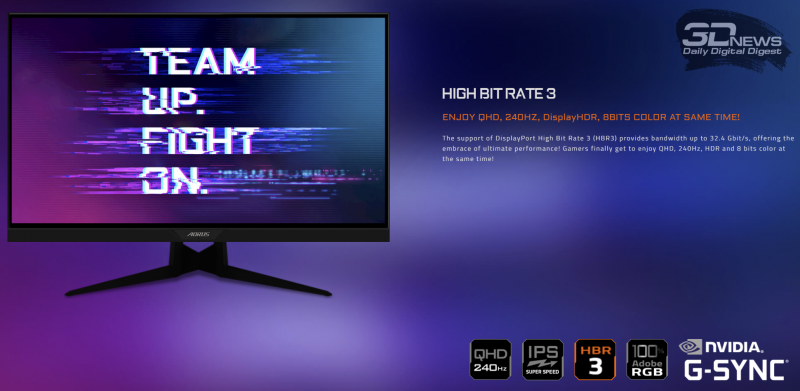
The diagonal of the panel used is 27 inches, the working resolution is 2560 × 1440 pixels (WQHD standard). The aspect ratio is 16: 9, and the final pixel density is 110 ppi – a familiar figure that provides sufficient image clarity without forcing the user to turn on the scaling system in Windows.
The figures for contrast and viewing angles are typical for an IPS monitor in the gaming segment. The maximum brightness level is not very high, but for most working conditions, 200 nits would be enough instead of the indicated 400.
In describing the speed characteristics, the manufacturer honestly indicates two numbers: 0,3 according to the MPRT standard (the time a frame appears on the screen in the mode with the AIM Stabilizer “black frame” insertion) and 1 ms GtG – the pixel response time at a certain color transition. For a 240Hz panel, these numbers seem reasonable.
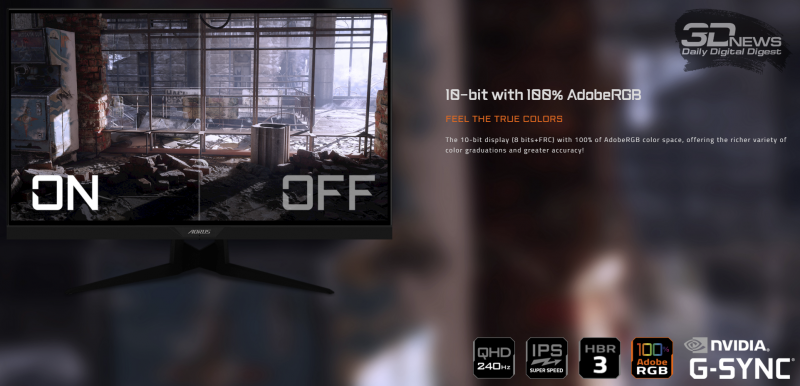
For the monitor, the operating range of vertical scanning is declared at 48-240 Hz, and AMD FreeSync Premium and NVIDIA G-Sync Compatible with officially declared compatibility are supported as adaptive synchronization systems. Only the Alienware AW2721D has a built-in hardware G-Sync module with an even wider range of work.
The list of available interfaces for connecting the AORUS FI27Q-X is quite advanced: two HDMI 2.0 versions and one upgraded DP 1.4. Thanks to the latter, the manufacturer speaks of the “technology” High Bit Rate 3 (HBR3), which allows organizing data transfer at a speed of 32,4 Gb / s (versus the standard for DP 1.4 26 Gb / s). This allows the monitor to work seamlessly with maximum resolution, high vertical scanning frequency and HDR enabled, without cutting back the working range and with a color depth of 10 bits.

For connecting headphones and a microphone, the monitor has 3,5 mm audio jacks, and for working with peripherals there are two USB 3.0 with fast charging. There is no built-in audio system in the new product, as in many other AORUS gaming solutions, and this is normal, since players usually use a headset or a high-quality speaker system.
In its latest solution, the company has used Black Equalizer and ANC technologies of the second version. In the first case, other impact algorithms are used when highlighting shadows, but for some reason the vertical frequency is limited to 165 Hz, which the manufacturer gives a warning about in the monitor menu itself. Gigabyte also kept the first version in the Black Equalizer list with a coarser adjustment, but without frequency restrictions.
Для ANC 2.0 монитор использует обновлённый аудиочип для фильтрации постороннего шума (активного шумоподавления) с увеличенным до 120 дБ соотношением «сигнал — шум» (SNR), что позволяет использовать высокоомные наушники с высоким импедансом, до 600 Ом.

Список особенностей монитора продолжает знакомая нам функция Dashboard. Она позволяет выводить техническую информацию (напряжение, температуру и частоты CPU/GPU, скорости вращения вентиляторов и тому подобное) на экран в режиме реального времени. Подобное можно реализовать и силами стороннего программного обеспечения, но Gigabyte предлагает данную функцию, что называется, из коробки.
Gigabyte devotes whole odes to the Blue Light Reducer (blue component of the spectrum), PbP / PiP (picture-in-picture and picture-by-picture) functions, and USB Charger (the ability to charge devices via USB). The list continues with GameAssist and Sidekick. The first serves to display the on-screen sight, timer, counter and various grids, and the second allows you to configure the monitor through a special utility for Windows.
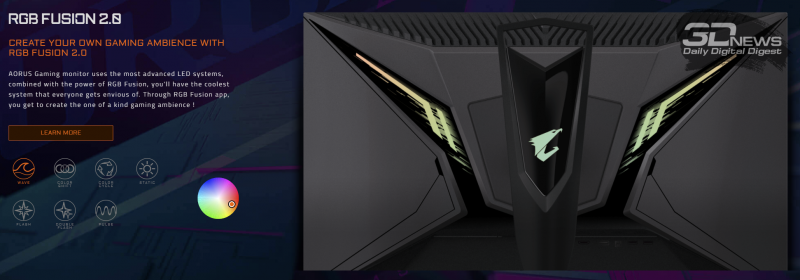
Other technologies typical for the brand’s gaming monitors include the use of the already familiar RGB-illumination of the external space called Fusion 2.0. For its deep setting, an application with the appropriate name is highlighted, and through the usual monitor menu, the user can select one of three operating modes.
⇡ # Package and appearance

The Gigabyte AORUS FI27Q-X monitor comes in exactly the same packaging as its predecessor. The box for the 27-inch model is very large, but the monitor and its stand are well protected.
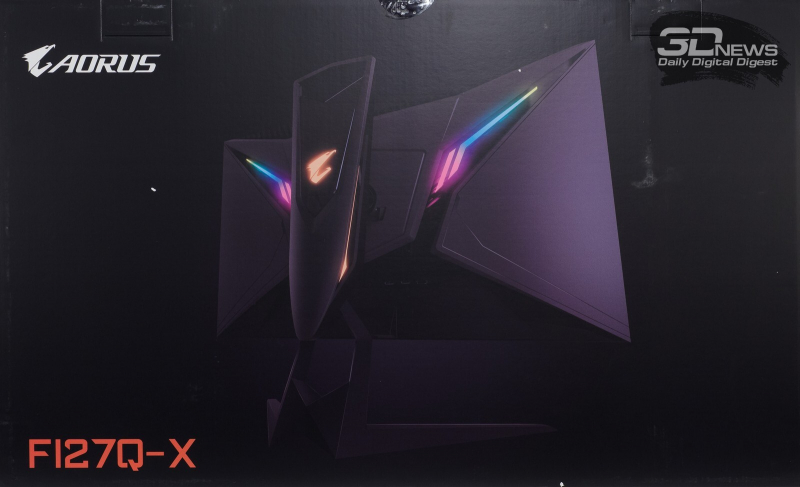
The manufacturer refused from the additional cardboard box and left only the main one – the colorful one.

But the plastic handle remained in place for easy transport.
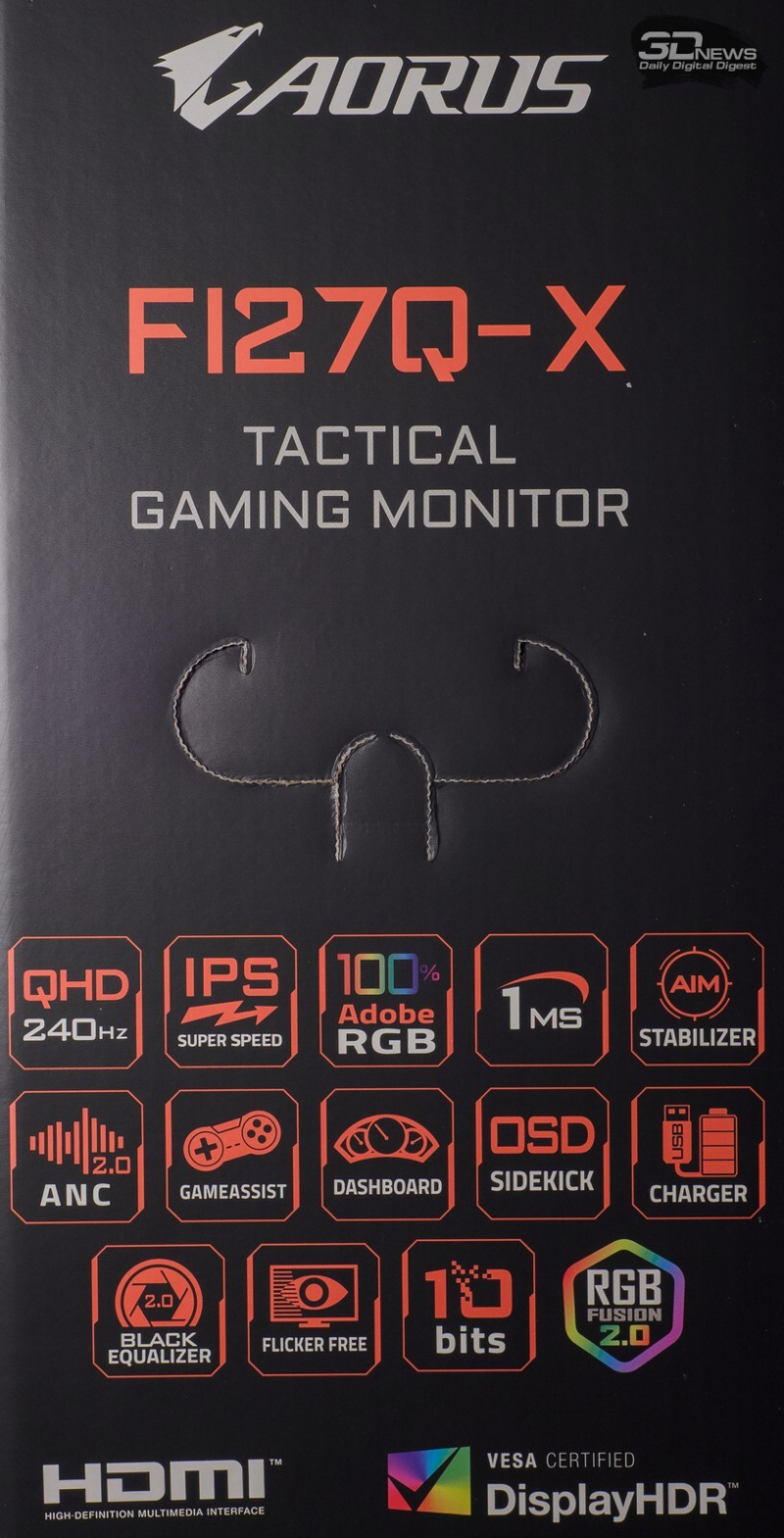
The package contains two photographs of the model, as well as a complete list of the solution’s features in the form of small colorful pictograms placed on several sides.

The general list of features of the model has 16 items, and by the information stickers you can find out the batch number, serial number, full name of the monitor, its weight and country of manufacture (China).
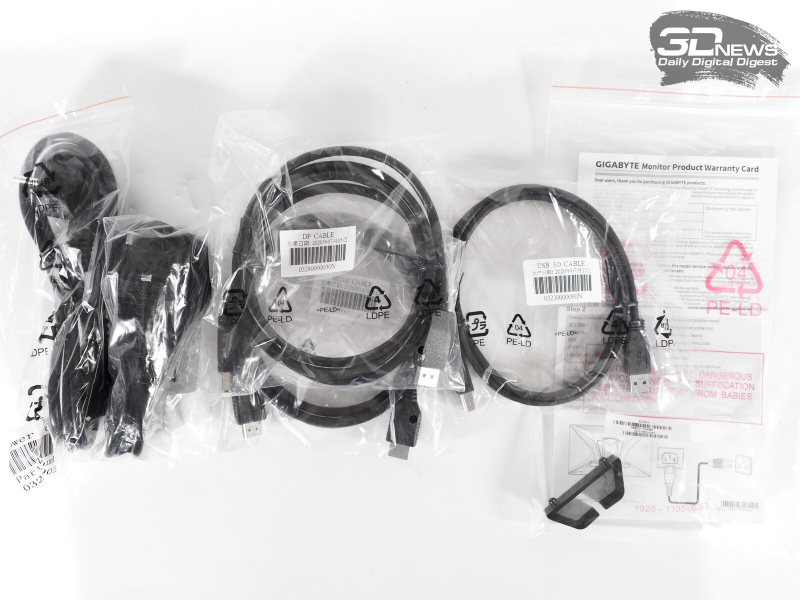
The delivery set of the new item includes everything you need:
- power cable (2 pcs. of different standards);
- HDMI cable;
- DP cable;
- USB cable for connecting the monitor to a PC;
- CD with drivers and utilities;
- a short user guide for initial setup;
- guarantee ticket.
In the case of the hero of the review, both types of video interfaces are well suited for connection, however, if you want to reach the maximum possible (10 bit + 240 Hz + HDR + Adaptive-Sync), then the only possible option is DisplayPort connection using the cable from the kit – this is important. If you just take some kind of DP cable, then you will encounter flickering, stripes-artifacts across the entire matrix field, image reloading and other problems. The reason for this is the high prevalence of cables that meet the DP 1.2 specification and lower, but “reinforced” cables with DP 1.4 compliance are quite rare, mainly in the delivery sets of the corresponding display models.
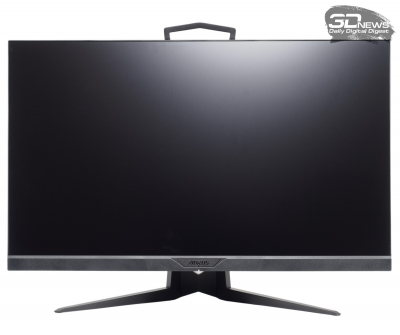 |
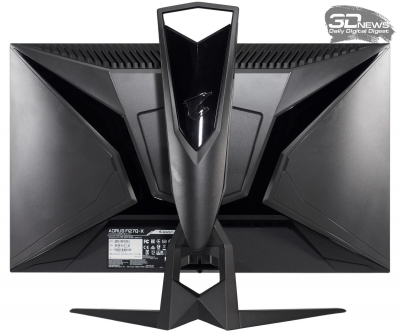 |
Внешне новинка является полной копией AORUS FI27Q-P и самого первого монитора AORUS – AD27QD, а поэтому последующее описание дизайна повторяет ранее сказанное нами из их обзоров.
The appearance of the FI27Q-X shows the features of many modern solutions from a wide variety of segments. Something Gigabyte designers adopted from ASUS or Acer gaming monitors and even borrowed ideas from MSI.

The result was solid, memorable and, what is important for a game model, bright.
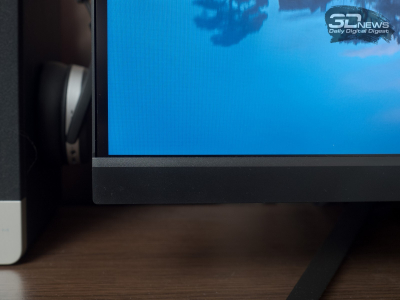 |
 |
The matrix used is packed in a modern “frameless” case with minimal internal frames on three sides. At the bottom, we are greeted by a wide plastic overlay with the AORUS logo.
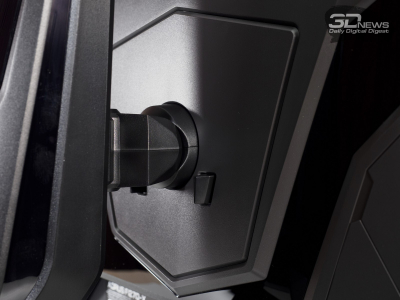 |
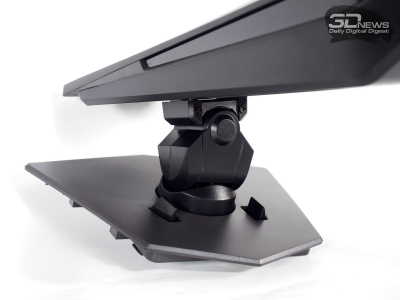 |
Центральная колонна изначально прикреплена к корпусу, а для её демонтажа необходимо не просто зажать один пластиковый фиксатор-кнопку, как это делается у других мониторов, а свести друг к другу две направляющие, после чего перед пользователем предстанет стандартная VESA-совместимая площадка стандарта 100 × 100 мм.
 |
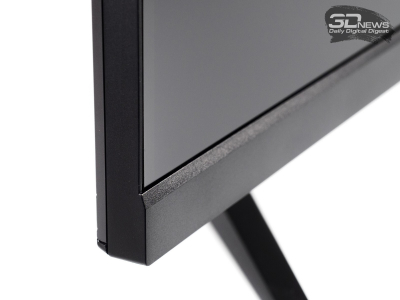 |
As a stand, the company’s designers have chosen a very effective solution – to match the segment in which the monitor is presented, but we cannot call it comfortable. Firstly, it is quite deep, and secondly, its width is quite large for a relatively small by modern standards matrix with a diagonal of 27 inches. On the other hand, such an assessment is extremely subjective. The end consumer’s attitude to the stand used will depend on how much space he has available on the table and how far away he is ready to place the monitor. If the stars converge, then there will be no problems.
 |
 |
As for other important parameters of the stand, everything is in order here: it looks good, the workmanship is high, and the stability of the monitor is excellent. The cable routing system is realized due to a plastic holder installed in the lower part of the case, as well as a figured cutout in the central column. For the convenience of carrying the display, a kind of handle is made in its upper part.

Эргономика подставки удовлетворит запросы всех без исключения потребителей: доступно изменение наклона (от -5 до +21 градуса) и высоты (130 мм), а также поворот корпуса вправо/влево (на 20 градусов).
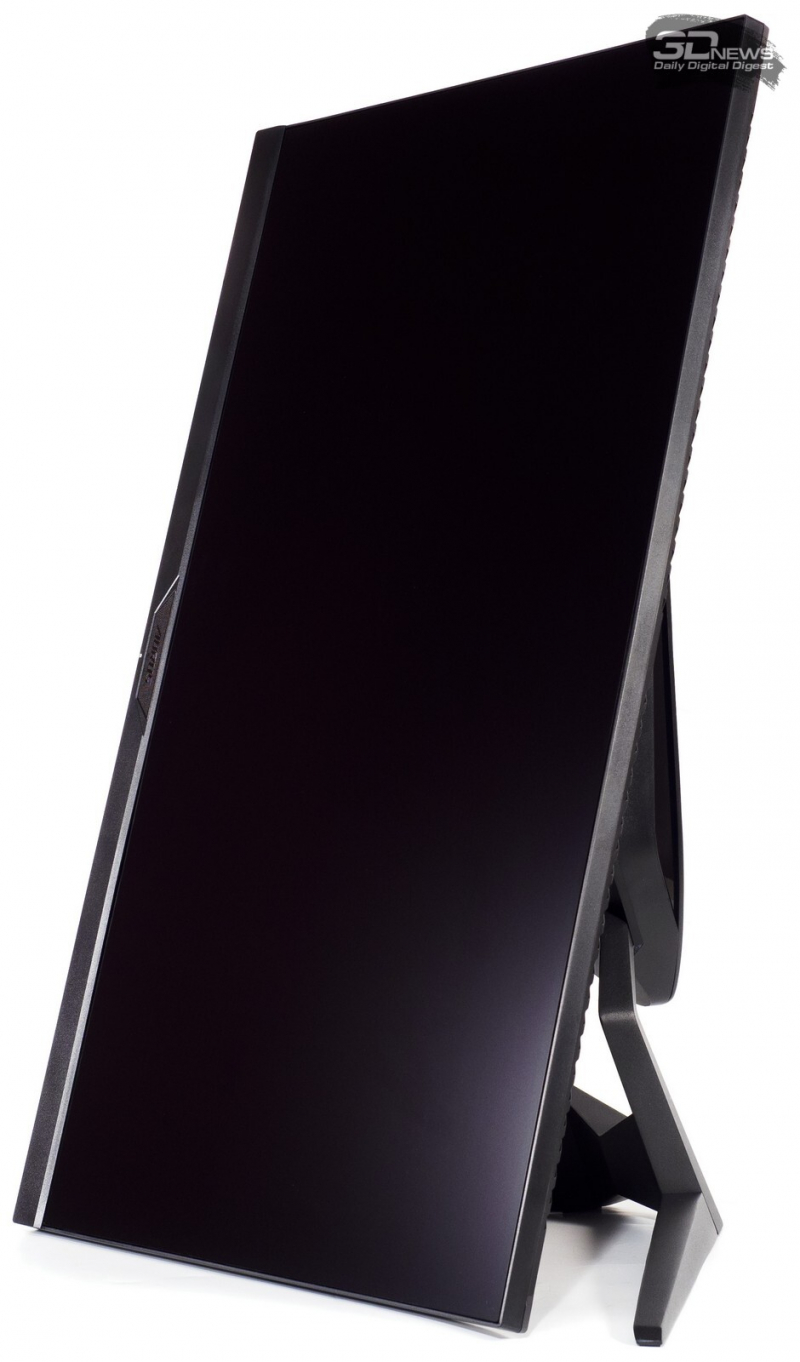
Присутствует возможность переворота в портретный режим (Pivot), из-за которой, к нашему удивлению, центровка корпуса почти не пострадала, хотя люфт в левую сторону всё же имеется.

All mounting elements of the monitor, including the internals of the stand and base, are made of metal. For reliable grip on the working surface, four rubber feet of different shapes are used – they are good at holding the monitor in one position, also due to the rather large weight of the device.
RGB illumination of the external space RGB Fusion 2.0 is divided into several local zones – we still do not see any differences from that of its predecessor.
The color spectrum of the backlight is as wide as possible. Through the monitor menu, you can select one of three operating modes – or turn it off completely. Fine tuning and synchronization with other products can be done thanks to a separate Gigabyte application.
As practice shows, demand creates supply, and people are ready to overpay for such backlighting systems even if, after installing the display on the desktop, the entire “New Year tree” will be visible only to the wall or employees passing through the office. Fusion 2.0 is not capable of creating atmospheric backlighting – its brightness is too low.
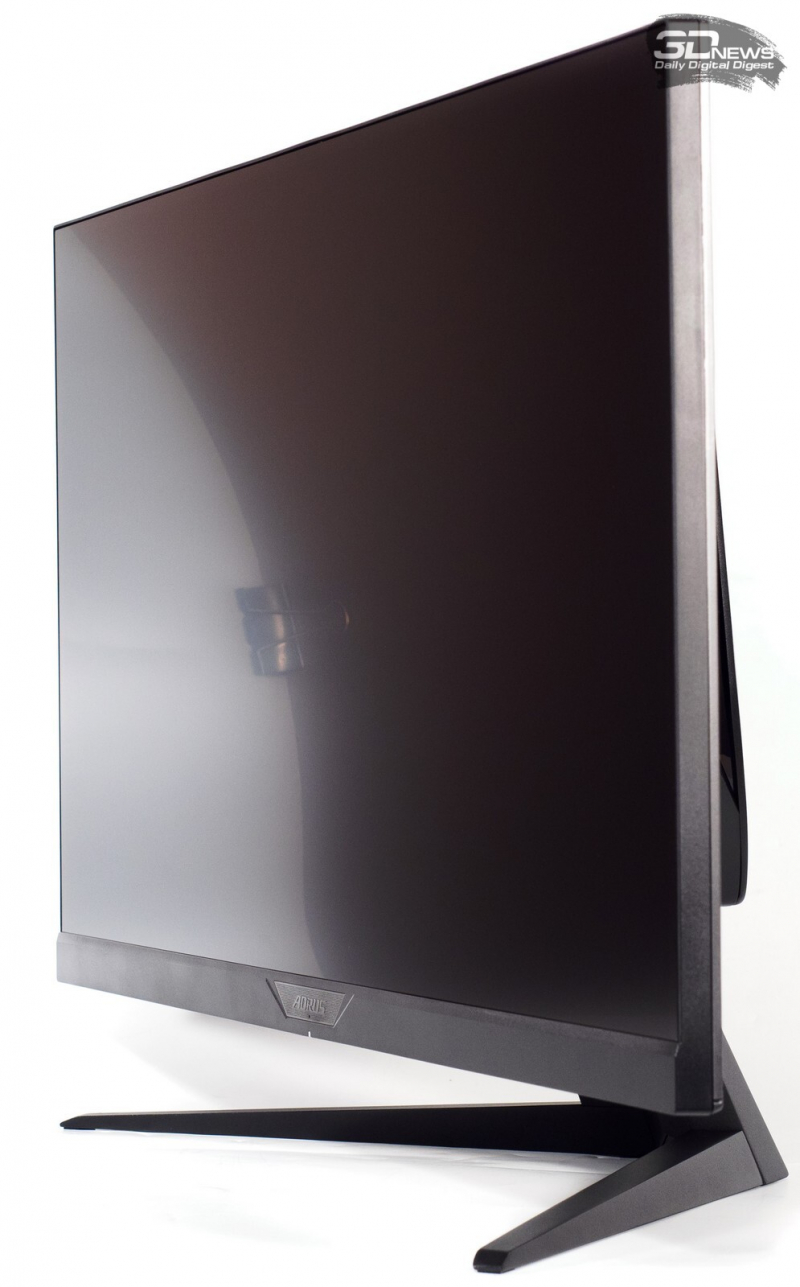
В продолжение темы технических особенностей стоит отметить, что герой обзора оснащён IPS-type-матрицей с полуматовой рабочей поверхностью, которая должна бороться не только с бликами на экране, но и с раздражающим кристаллическим эффектом. Справляется она с этой задачей достойно.

By the sticker on the body of the device, you can check all the numbers (serial, batch number, and so on) and finally find out the approximate production date. The copy that came to us was released in October 2020 and, most likely, was made directly by Gigabyte itself.

All interfaces for connection are located in the back of the case, on one block, and are directed downward. Due to the possibility of flipping the case into portrait mode, there are no problems with connecting cables.

По специальным прорезям в задней части корпуса можно было бы предположить, что в мониторе предусмотрена встроенная акустическая система, однако инженеры и маркетологи компании вновь решили обойтись без неё. Как считают многие производители, настоящие геймеры используют гарнитуры, поэтому инженеры фокусируются на размещении аудиоинтерфейсов и удобстве подключения к ним.
In appearance and quality of the materials used, the monitor is perceived as an expensive device. The processing of elements in FI27Q-X is performed at the highest level, the gaps are uniform along the entire length of the joints. The plastic is not black, but dark gray, the practicality of many elements is high, but this certainly does not apply to translucent plastic inserts in places where RGB Fusion backlights are present, on which scuffs and a lot of scratches – small and not so much – quickly appear.
The monitor does not creak or crunch when twisted or repositioned. To paint, too, do not find fault. In terms of quality, the Gigabyte AORUS FI27Q-X is ahead of most 27-inch WQHD gaming solutions and is on par with the best of them. As for direct comparison with the main competitor Alienware AW2721D, the difference between the models is solely in design, and both are made and assembled perfectly.
⇡#Меню и управление
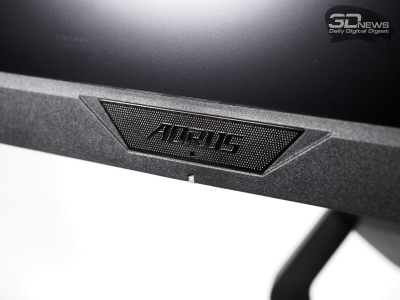 |
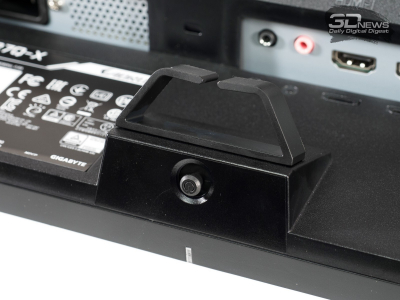 |
The basis of the monitor control system is a five-position joystick located in the middle of the lower edge of the case. A little higher, on the front frame, there is a power indicator with a white glow, which, if desired, can be either turned off or made half as bright.
Menu speed is fast. The system instantly responds to user actions – we did not notice any annoying delays. And thanks to on-screen prompts, it is easy and simple to control the monitor both during the day and at night, in the absence of external lighting.
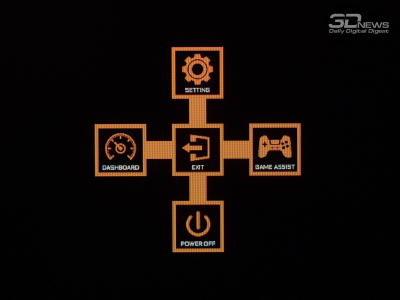 |
 |
Among the options with quick access (by moving the joystick to one of four positions), the following are available by default: source selection, black equalizer, transition to preset Picture Mode and volume control of connected headphones or speaker system. If desired, the functions of all four positions of the joystick can be changed – the choice of options is wide enough.
When you press the joystick at the bottom of the screen, a familiar block of five navigation buttons appears. Thanks to them, you can go to the main menu, turn off the monitor and quickly get to the settings for the GameAssist and Dashboard functions.
The appearance of the OSD menu is a design mixture from what we could see in Samsung and BenQ monitors, but made in a different color, without much emphasis on any details. Everything is simple and concise. Before us is the upper block with six items, which the manufacturer considered the main ones, and six sections (the seventh, with the only reset function, we do not take into account), the settings of which were decomposed into three additional sections.
The FI27Q-X differs slightly from its predecessor in terms of the menu content, but this mainly concerns the change in the names of some items.
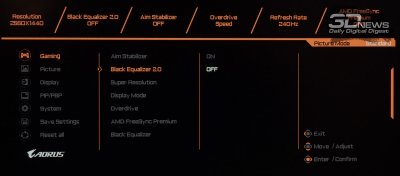 |
 |
The first section, Gaming, provides access to the so-called gaming parameters, including AIM Stabilizer, Black Equalizer 2.0 and simply Black Equalizer, Super Resolution, Display Mode (built-in scaler settings), Overdrive matrix overclocking settings and the ability to activate AMD FreeSync Premium (required, specifically to enable NVIDIA G-Sync Compatible).
Adjustments for brightness, contrast, gamma, sharpness, color temperature and color saturation are highlighted in the Picture section. Here you can also select one of the preset image modes and activate the filter of the blue part of the spectrum (Low Blue Light).
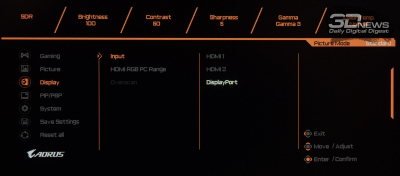 |
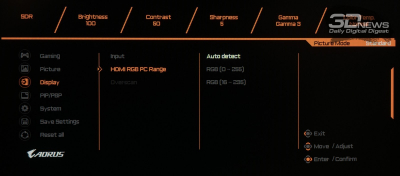 |
In the third section, you can find the ability to select the image source, change the tonal range when using the HDMI interface and enable Overscan.
 |
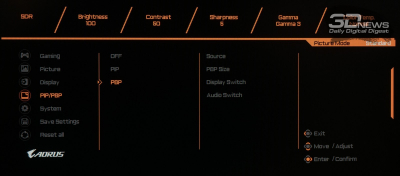 |
A wide range of options for configuring the PiP and PbP functions are presented in the next section, with the corresponding name.
 |
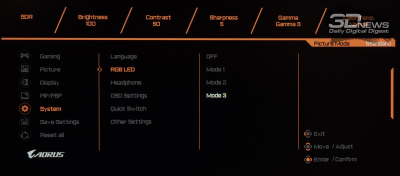 |
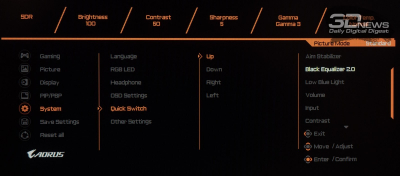 |
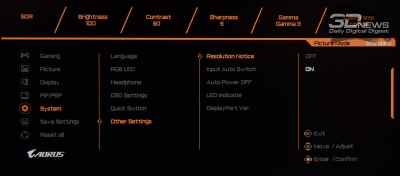 |
In the System section, there are RGB lighting settings (three modes of operation), selection of an audio signal source and functions for quick access, changing the appearance and language of the menu localization.
The Russian translation, once again, is not entirely correct, in a lower quality font and is not produced everywhere – the preliminary menu block always remains in English.
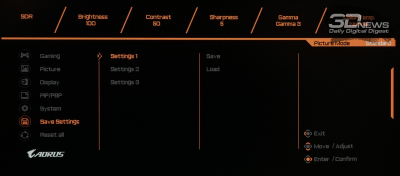 |
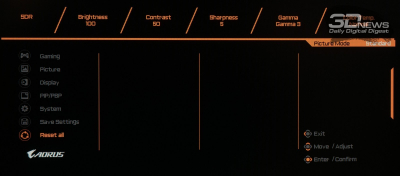 |
В дополнительных настройках данного раздела можно отключить уведомления о рабочем разрешении, изменить яркость индикатора питания, версию DP (в том числе 1.4 с HDR), активировать автоматическое выключение и автоматический переход к подключённому источнику.
Несколько более широкий список возможностей в более наглядном виде представлен через приложение OSD Sidekick, способное заменить поход в стандартное меню монитора. Многим потребителям такой способ управления дисплеем покажется более удобным. C его возможностями мы знакомились уже не раз.
⇡ #Testing technique
The AORUS FI27Q-X monitor was tested using the X-Rite i1 Display Pro colorimeter in combination with the X-Rite i1 Pro reference spectrophotometer, Argyll CMS software with dispcalGUI GUI and HCFR Colormeter software. All operations were carried out in Windows 10, during testing, the screen refresh rate was 240 Hz, and the color depth was set to 8 bits (10 bits are not necessary for our tests).
В соответствии с методикой мы измерим следующие параметры монитора:
- white brightness, black brightness, contrast ratio at backlight power from 0 to 100% in 10% steps;
- color gamut;
- color temperature;
- gamma curves of three primary colors RGB;
- гамма-кривую серого цвета;
- отклонения цветопередачи DeltaE (по стандарту CIEDE1994);
- uniformity of illumination, uniformity of color temperature (in kelvin and units of deviation DeltaE) at brightness in the central point of 100 cd / mXNUMX2.
All measurements described above were performed before and after calibration. During our tests, we measure the main monitor profiles: default, sRGB (if available) and Adobe RGB (if available). Calibration is carried out in the default profile, with the exception of special cases, which will be discussed further. For monitors with wide color gamut, we select sRGB hardware emulation if available. Before starting all tests, the monitor warms up for 3-4 hours, and all its settings are reset to factory settings.
Также мы продолжим нашу старую практику публикации профилей калибровки для протестированных нами мониторов в конце статьи. При этом тестовая лаборатория 3DNews предупреждает, что такой профиль не сможет на 100% исправить недостатки конкретно вашего монитора. Дело в том, что все мониторы (даже в рамках одной модели) обязательно будут отличаться друг от друга небольшими погрешностями цветопередачи. Изготовить две одинаковые матрицы невозможно физически, поэтому для любой серьёзной калибровки монитора необходим колориметр или спектрофотометр. Но и «универсальный» профиль, созданный для конкретного экземпляра, в целом может поправить ситуацию и у других устройств той же модели, особенно в случае дешёвых дисплеев с ярко выраженными дефектами цветопередачи.
⇡ # Operating parameters
In the AORUS FI27Q-X monitor, the manufacturer offers seven preset modes and three additional (Custom), for completely manual adjustment. In our tests, we used DisplayPort 1.4 as the most hassle-free interface available.
By default, the settings for the main parameters are as follows:
- image mode – Standard;
- brightness – 60;
- contrast – 50;
- sharpness – 6;
- color temperature – Normal;
- gamma – 3;
- black equalizer – 0;
- Overdrive – Picture Quality;
During manual tuning (100 cd / mXNUMX2 and 6500 K), the parameters took the following form:
- image mode – Custom;
- brightness – 12;
- contrast – 50;
- sharpness – 5;
- color temperature – User Define (100/100/93);
- gamma – 3;
- black equalizer – 0;
- Overdrive – Balance / Speed.
To access the full list of required parameters, the user mode was selected (any of the three is suitable). After switching to it, there were no significant changes in the picture, and to obtain the necessary values, it was necessary to adjust only two parameters: brightness and color temperature (RGB Gain). The color gamut is set at the native level for the used matrix – DCI-P3. We changed the degree of Overdrive overclocking towards Balance and Speed, and increased sharpness to a level of 5 units – so the eyes are much more comfortable.
⇡ # White brightness, brightness of black, contrast ratio
The check was carried out in the “Standard” mode with the default settings.
| Brightness in the menu (%) | White Brightness (cd / mXNUMX2) | Black brightness (cd / mXNUMX2) | Static contrast (x: 1) |
| 100 | 443 | 0,465 | 953 |
| 90 | 408 | 0,428 | 953 |
| 80 | 372 | 0,391 | 951 |
| 70 | 333 | 0,35 | 951 |
| 60 | 296 | 0,31 | 955 |
| 50 | 257 | 0,27 | 952 |
| 40 | 217 | 0,228 | 952 |
| 30 | 176 | 0,184 | 957 |
| 20 | 131 | 0,137 | 956 |
| 10 | 87 | 0,092 | 946 |
| 0 | 42 | 0,045 | 933 |
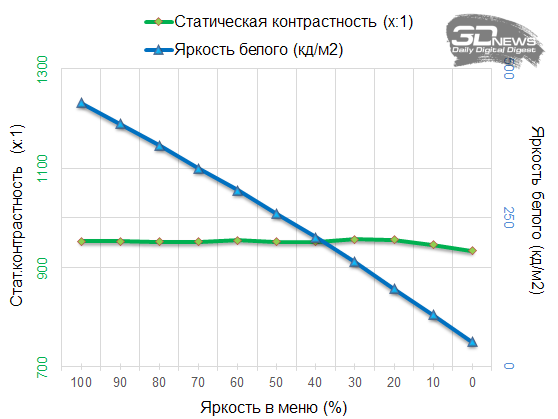
The maximum brightness was at the level of 443 cd / mXNUMX2, and the lower value was 42 cd / mXNUMX2… The contrast ratio is 950: 1 on average, which is 5% lower than stated in the technical specifications.
The resulting backlight brightness range turned out to be ideal from all points of view. On the upper border, the monitor slightly exceeds the declared bar of 400 nits, and the lower border will minimize the strain on the eyes in conditions of low external lighting or its complete absence.
⇡ # Results with standard settings
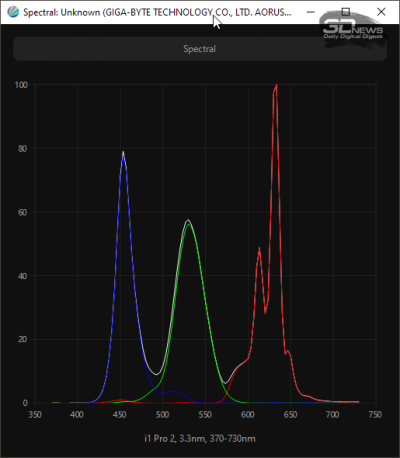
Производители матриц не планируют останавливаться в своих разработках: в дополнение к повышению частоты вертикальной развёртки изменения происходят и в возможностях цветовоспроизведения. Рассматриваемый сегодня AORUS FI27Q-X обладает матрицей с расширенным до уровня AdobeRGB цветовым охватом, что делает его интересным вариантом не только для использования в мультимедиа (игры, фильмы), но и для решения профессиональных задач, где требуются такие возможности.
Безусловно, данная особенность может создавать проблемы для людей, не разбирающихся в вопросах управления цветом, но если вы знакомы с Color Management System и готовы к созданию и использования ICC/ICM-профилей, то никаких проблем возникнуть не должно.
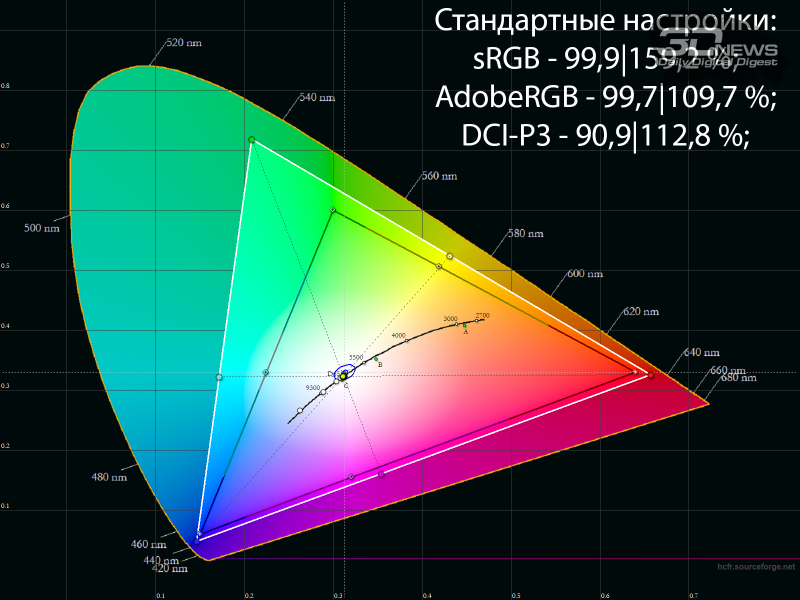
При настройках по умолчанию возможности матрицы в FI27Q-X соответствуют заявленным, особенно по части пространств sRGB и AdobeRGB. Изображение на экране насыщенное и зачастую не совсем реалистичное, поскольку до сих пор большая часть создаваемого контента рассчитана на sRGB-мониторы.

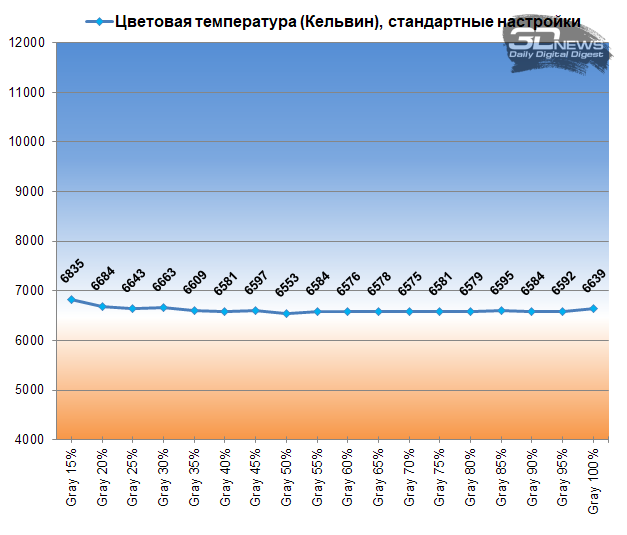
The white point of the AORUS FI27Q-X is tuned close to the reference, while the CG stability of the grayscale remains at a high level.
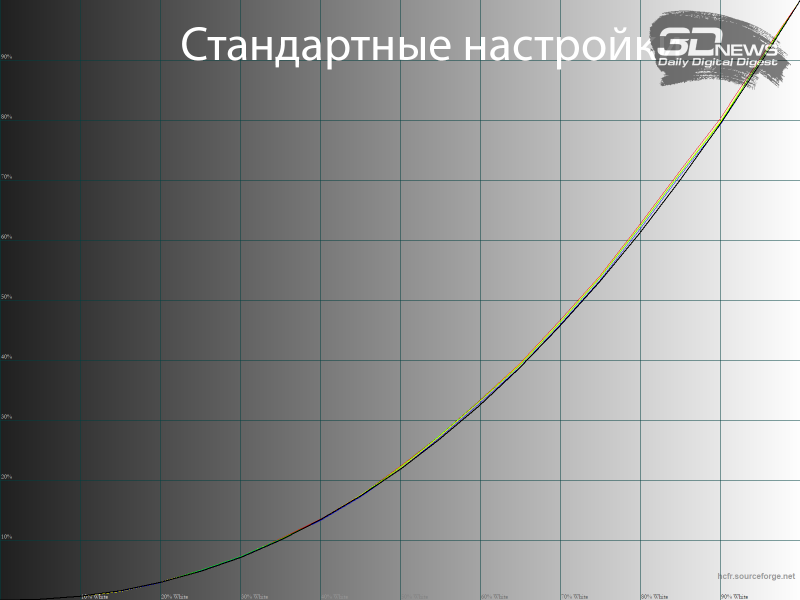
There are practically no discrepancies between the gamma curves, the lines run near the reference curve, and the shadows are adequate. Due to the slight rise in highlights, the contrast of the picture is slightly lower than required, but for most users this will not be a problem.
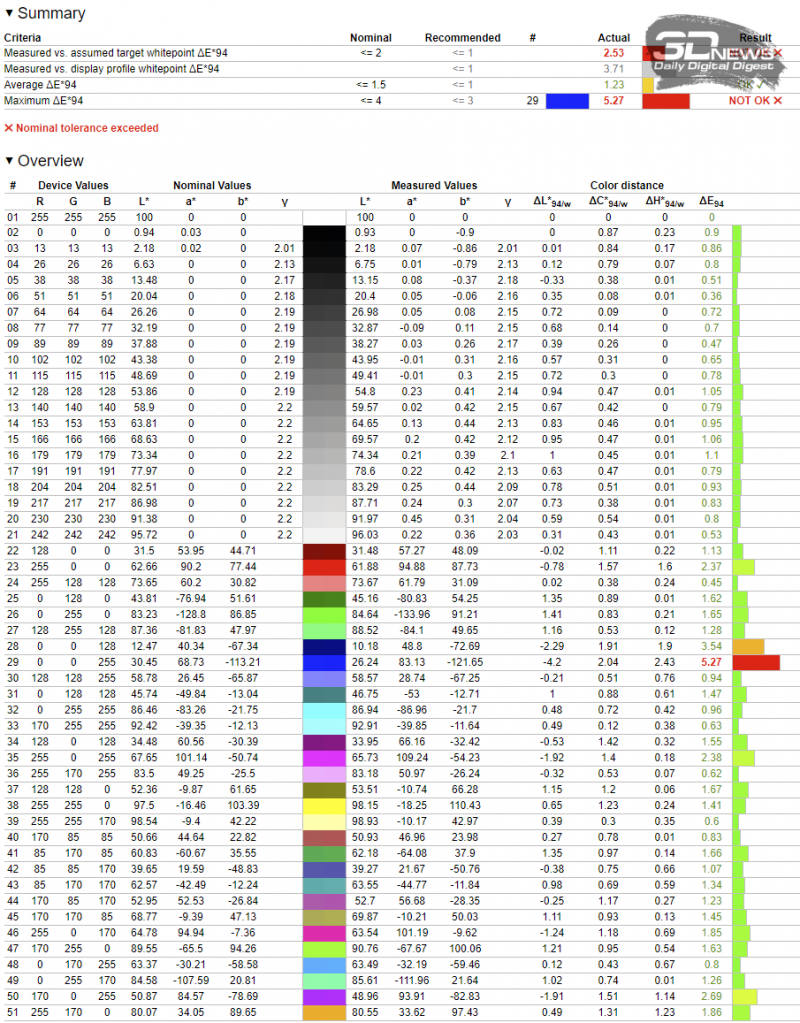
If we evaluate the overall accuracy of the monitor settings in relation to the AdobeRGB standard (and not sRGB and DCI-P3, as we do in most cases), then the model has shown itself worthy. The only identified problem is the blue color, but against the general background it is a drop in the ocean that can be ignored.
⇡#Результаты в режиме AIM Stabilizer
При активации AIM Stabilizer электроника монитора блокирует яркость на уровне 185-190 кандел без возможности дальнейшей регулировки. Коэффициент контрастности не снижается и продолжает держаться на уровне ~950:1.

The color gamut increases within the measurement error, and therefore you will not see visual changes.

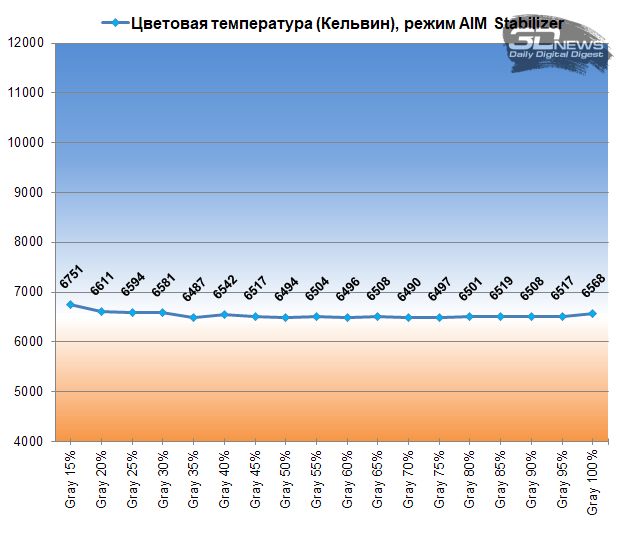
Ситуация с точкой белого ровно такая же. Стабильность серого при этом сохранилась на прежнем — высоком — уровне.
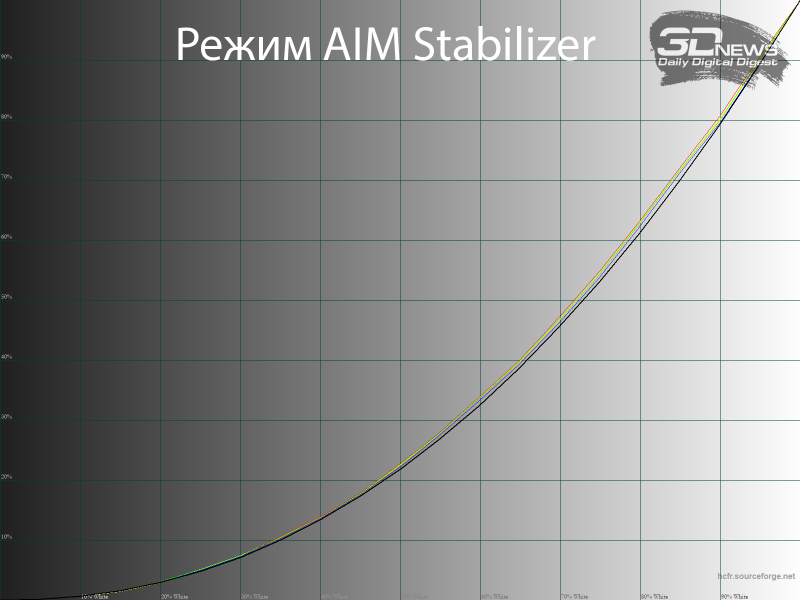
Влияние «чёрного кадра» на гамма-кривые оказалось незначительным, хотя у многих мониторов это бывает с точностью до наоборот.
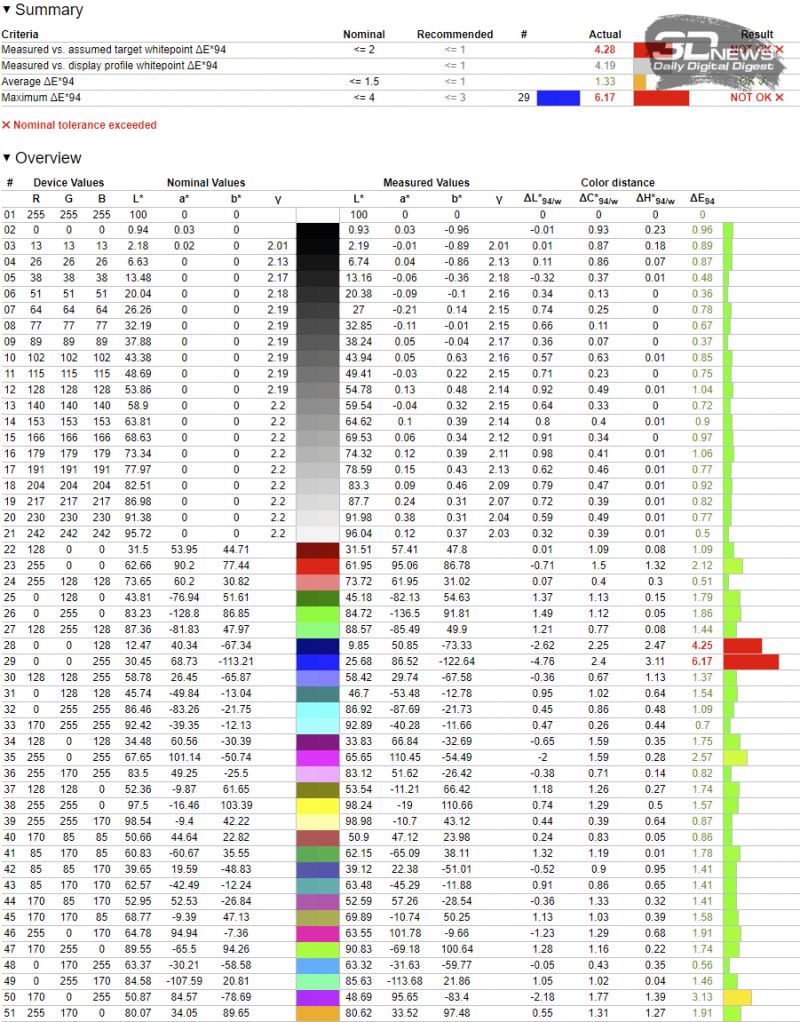
When the AIM Stabilizer option is activated, a second problematic color appears in the Argyll CMS report, but this is a reason to abandon the use of technologies. Feel free to use and be sure of the correct color rendition.
⇡ # Results in Reader mode
Reader mode is needed to reduce eye strain – it is analogous to Low Blue Light.
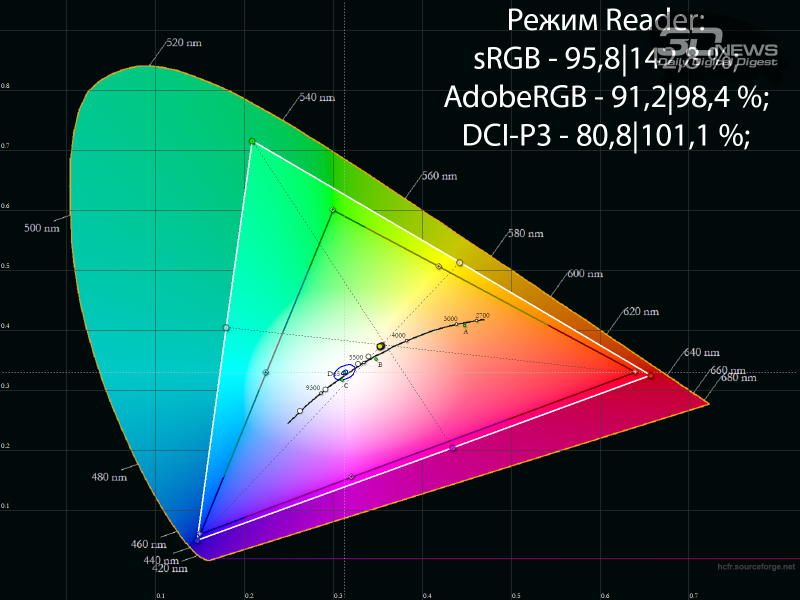
При переходе в него яркость снижается до 230 нит, цветовой охват ощутимо падает, а картинка приобретает «тёплый» тон.
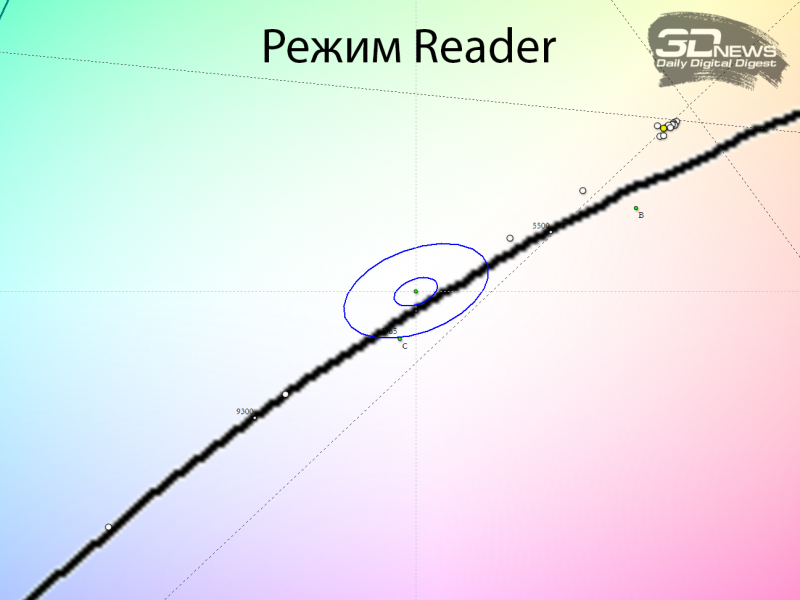

The white point floats away from the norm (for the Reader and its counterparts, this is an expected story), but the stability of the CG of shades of gray remains at an initially high level.
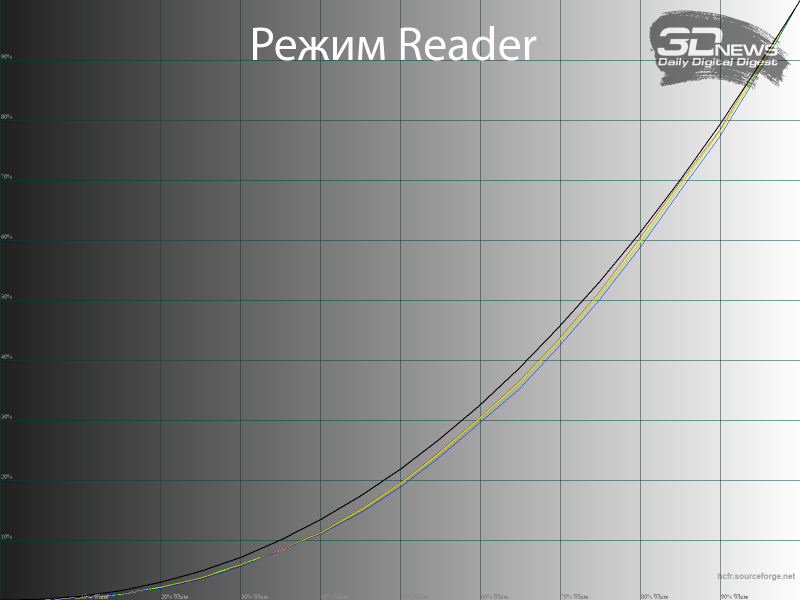
The gamma curves show more and more RGB imbalance, and all the lines pass below the reference, which leads not only to an increase in the overall contrast of the image on the screen, but also to a strong decrease in visibility in the shadows. So, obviously, the load on the eyes cannot be reduced!
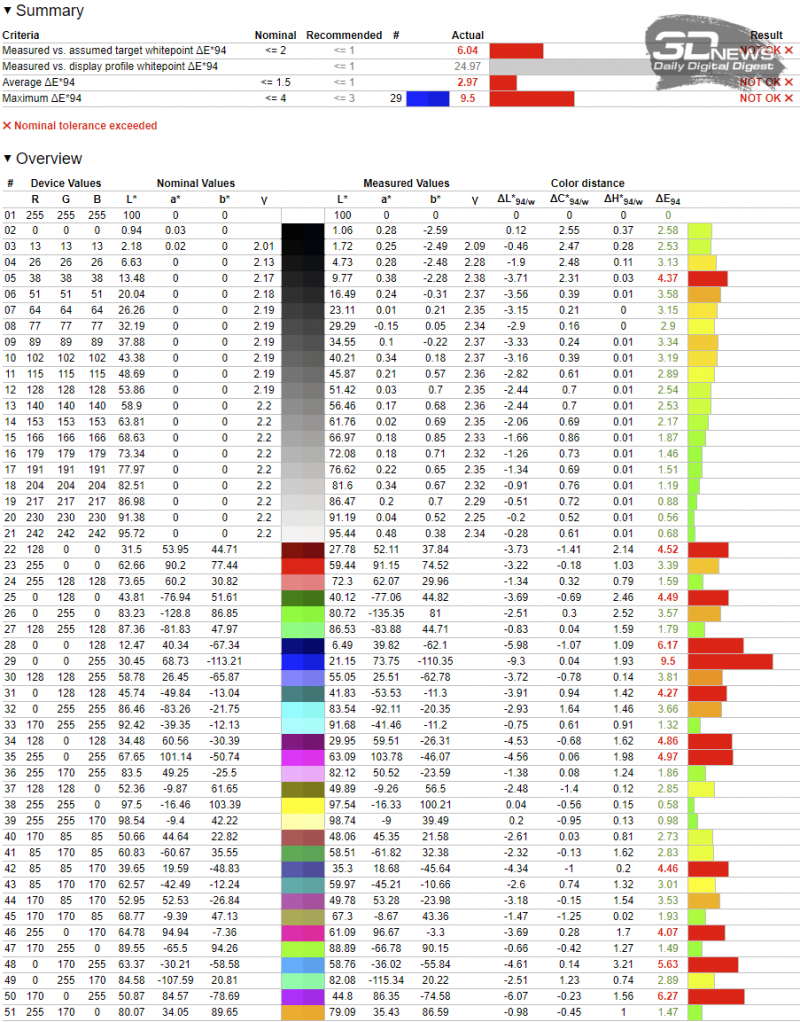
With all the changes identified, it is no surprise that the DeltaE94 deviation levels exceed acceptable values. Thus, if you want to reduce eye strain, it is better to switch to the “Gamma 1” or “Gamma 2” modes and manually reduce the blue component of RGB. Better results are guaranteed!
⇡ # Results in sRGB mode
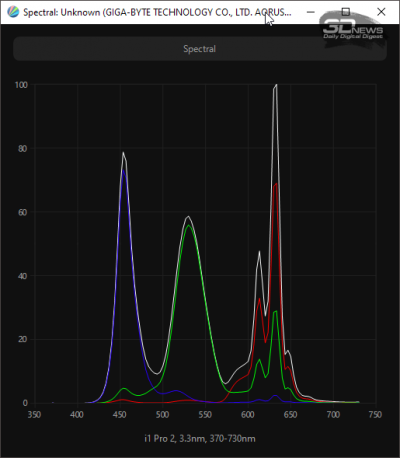
Поскольку FI27Q-X — монитор с расширенным цветовым охват, в нем неудивительно встретить режим эмуляции sRGB. В нём происходит подмешивание компонент в чистые цвета, что приводит к сужению ЦО.
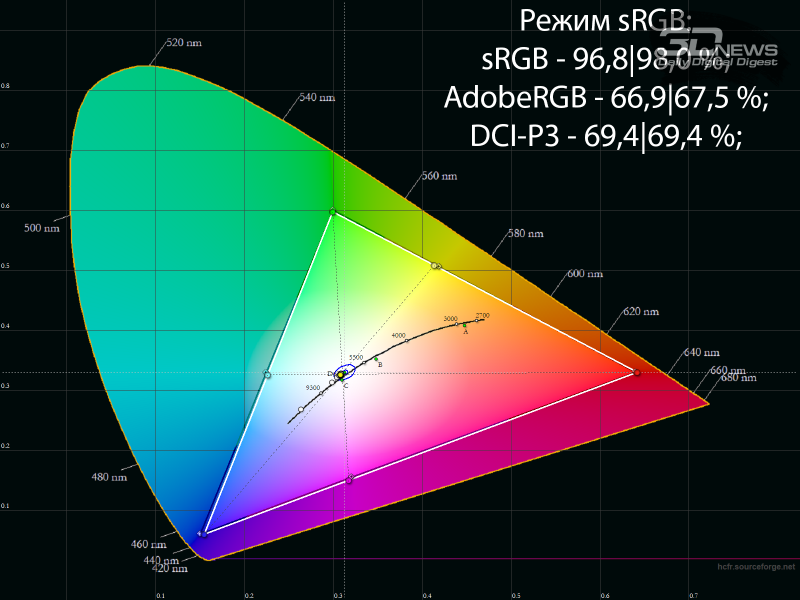
Эмуляция sRGB производится на очень хорошем уровне, изначальная яркость устанавливается на 23 % (144 нит), но её разрешено менять.
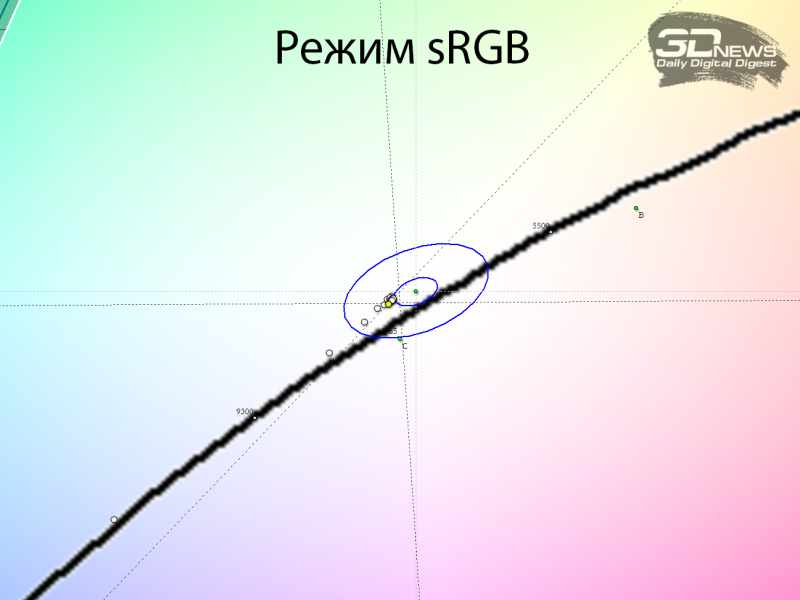
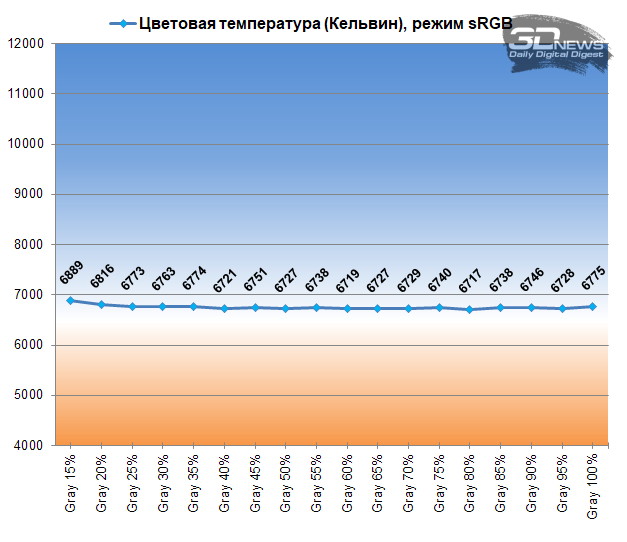
The white point is adjusted in this mode even closer to 6500 K, and the lowest DeltaE deviations and the high stability of the CG grayscale tell us that additional adjustment can be dispensed with.
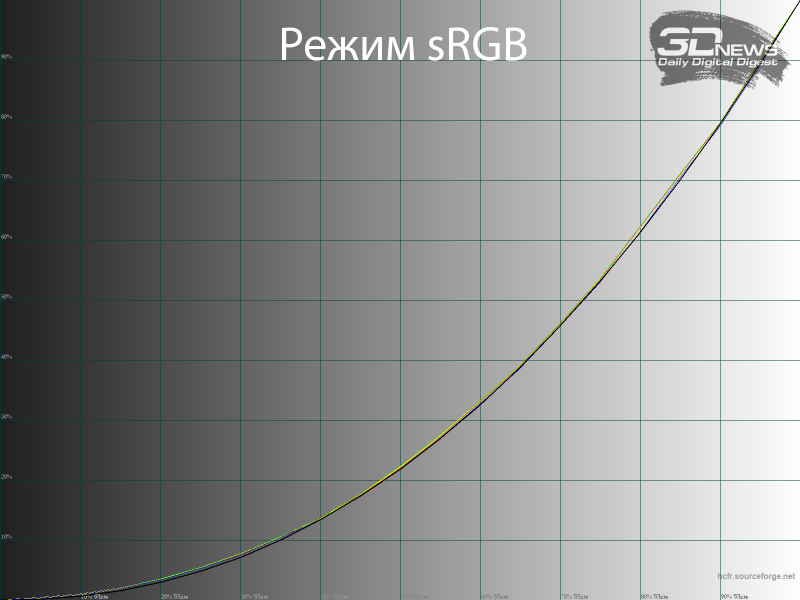
In the sRGB emulation mode, the gamma curves are set strictly in accordance with the requirements of the standard: shadows are clearly distinguishable in the picture, the most correct contrast and the smooth transmission of bright shades.
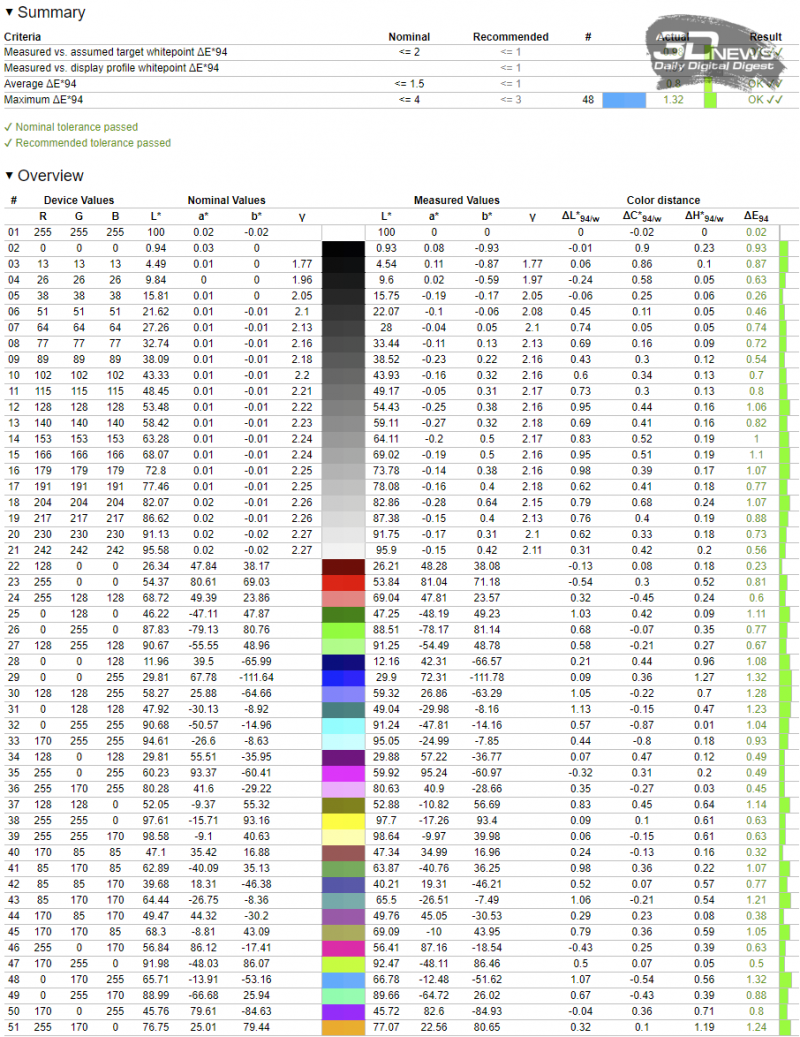
The proven mode has confirmed the success of Gigabyte in the field of display development. Thanks to it, consumers who prefer more natural color reproduction will be 100% satisfied.
⇡ # Results after calibration
Теперь вернёмся к стандартным настройкам и из них перейдём в один из трёх пресетов Custom для полноценных пользовательских изменений. В случае AORUS FI27Q-X необходимо снизить яркость подсветки и изменить степень усиления RGB для достижения необходимой цветовой температуры. При переходе в Custom режим «Гамма» переходит в положение «Выкл.», но для получения необходимых результатов мы вернули его в выставленное с завода «Гамма 3».
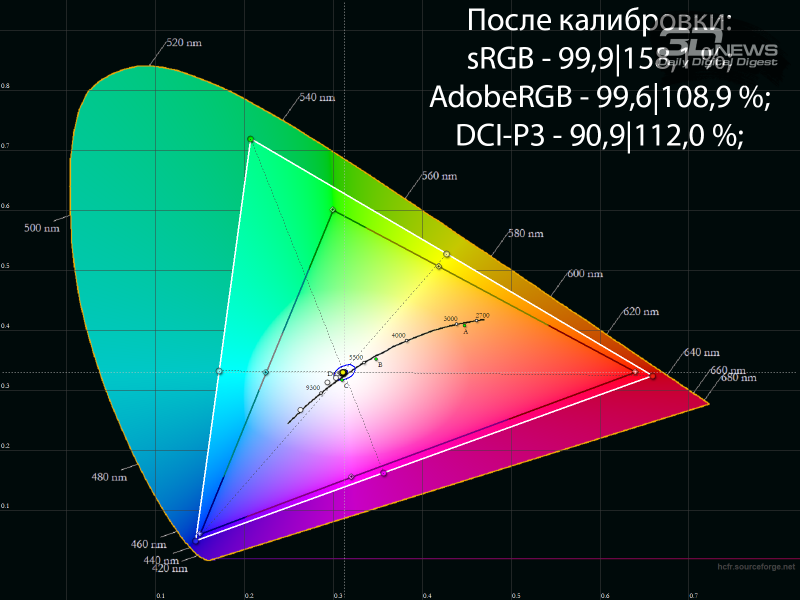
The changes made did not affect the color reproduction capabilities in any way. Color compliance with various standards remained at the original level with minor differences.
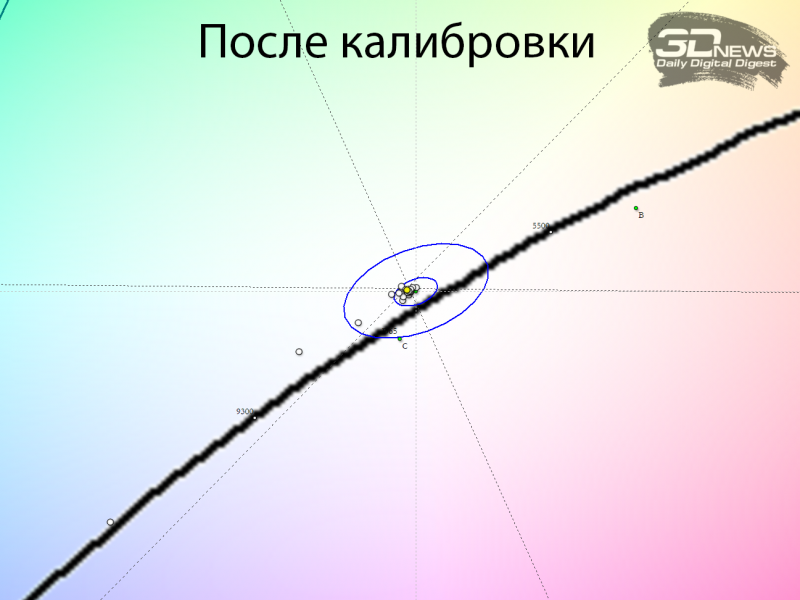

The white point bounced back and the grayscale stability dropped slightly, but still remained at a high level.
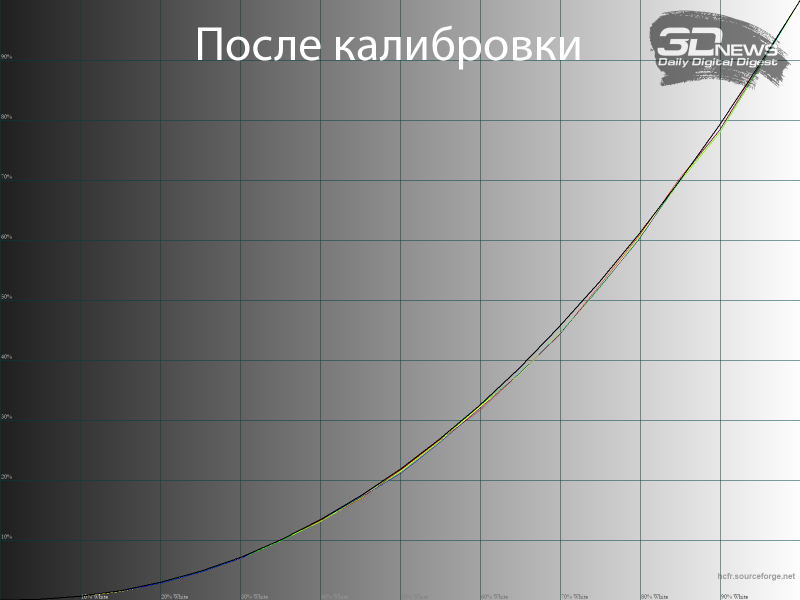
The resulting gamma curves after applying the created LUT profile showed us that the monitor could do with simple profiling, without making edits to the signal. This would keep the image contrast more accurate and without lowering the quality of the gradients.
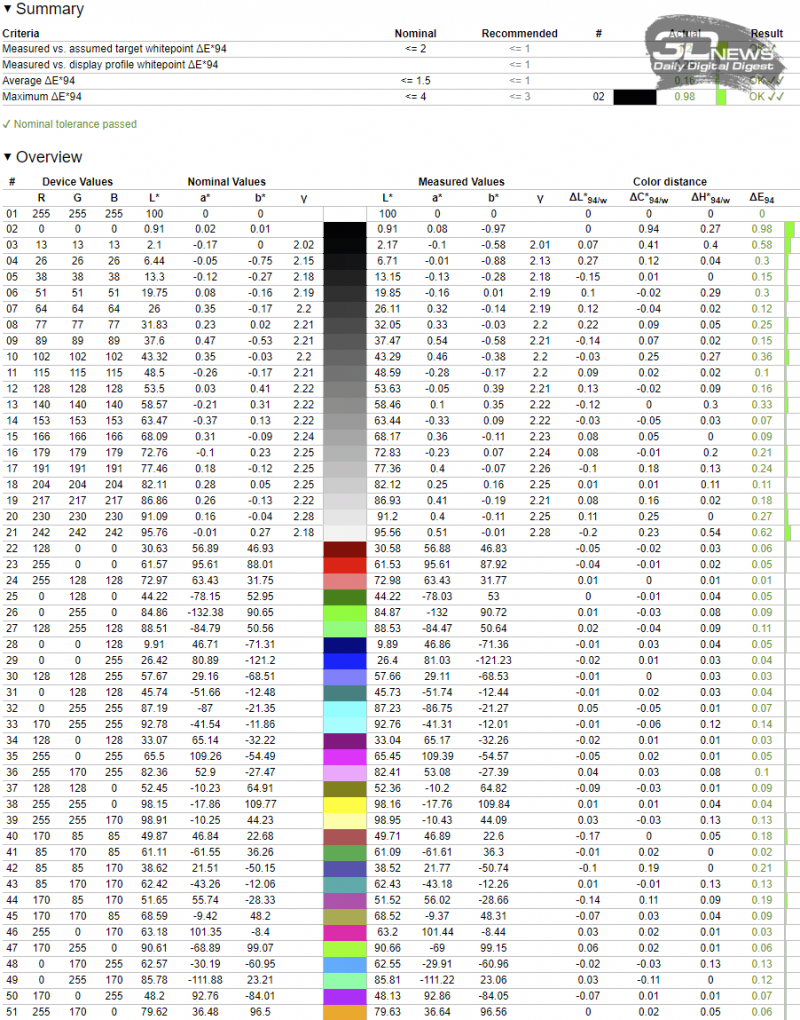
Nevertheless, thanks to the created profile, the system received all the data it needed about the capabilities of the display, which allowed programs with CMS support to make the necessary corrections. DeltaE variances decreased to 0,16 on average and 0,98 at maximum.
⇡ # Backlight uniformity
Равномерность подсветки дисплея проверялась после снижения яркости в центральной точке монитора до уровня 100 кд/м2 and setting the color temperature to ~ 6500 Kelvin.
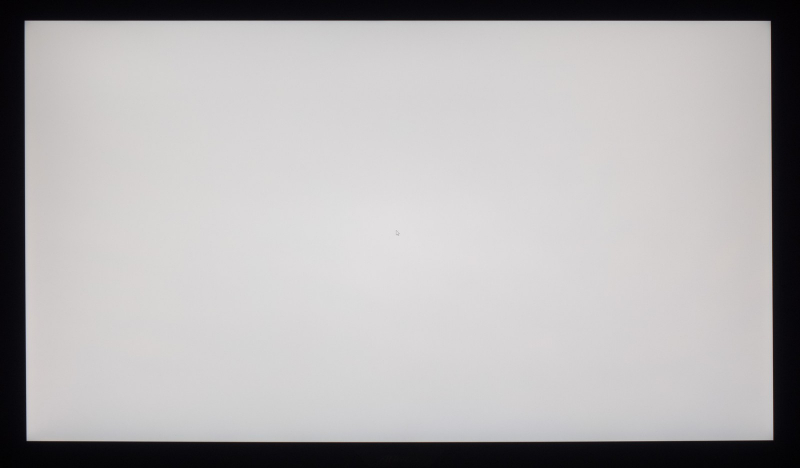
The picture above shows a photo of a white field with a certain exposure adjustment during shooting (in the dark) and further software processing for a more visual representation of the uniformity of the backlight.
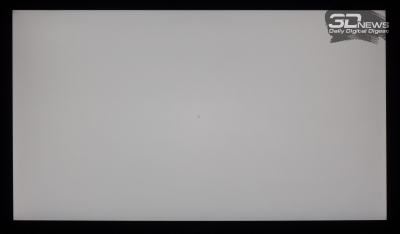 |
 |
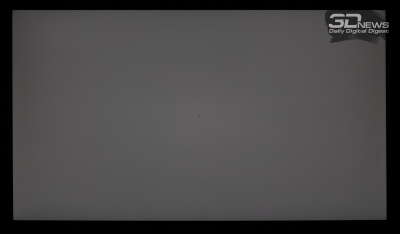 |
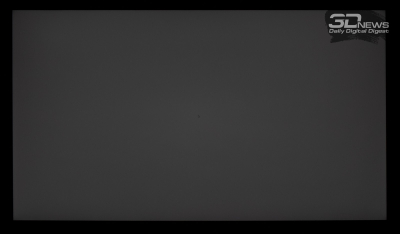 |
On white, the backlight uniformity problems are not very visible, but when you look at the gray field, they become more pronounced, especially the oval area in the middle.
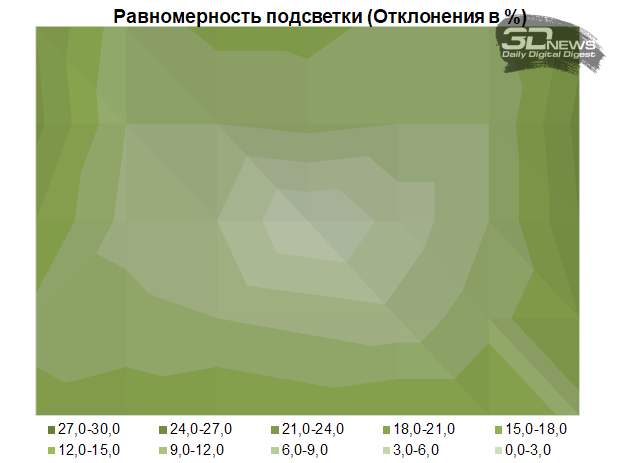
The average deviation from the center point was 11,6%, and the maximum was 19%. The result for a 27-inch screen is not the best, especially the average value spoils the overall impression.
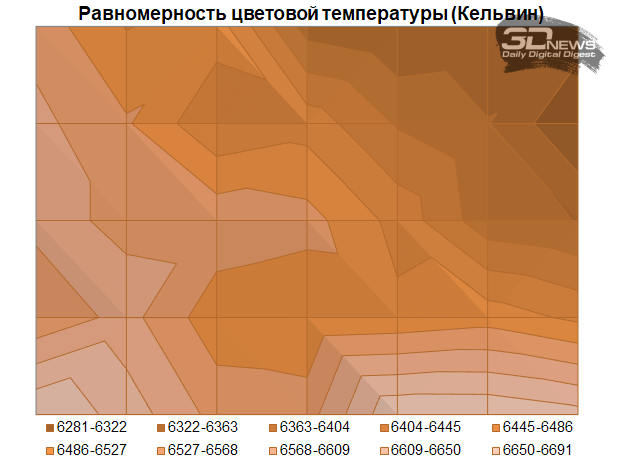
С равномерностью цветовой температуры у нашего экземпляра дела обстоят лучше. Разброс значений составил всего 410 кельвин, среднее отклонение от центральной точки – 1,4 %, а максимальное – 4 %. Это очень хороший результат, который позволит вам забыть о визуальной разнице между белым и серыми полями на разных частях экрана.
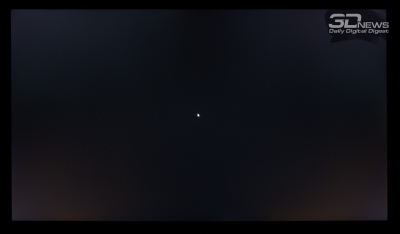 |
 |
Теперь посмотрим на равномерность подсветки и различные цветовые эффекты в случае с чёрным полем. Сделаем мы это по двум фотографиям, снятым на разном удалении от экрана (~70 и 150 см).
В плане углового Glow-эффекта изучаемый монитор показал низкий результат – четыре «засвеченных» угла с сильными паразитными оттенками. Размер «засветок» зависит от расстояния до экрана – чем ближе, тем они больше.
When moving away from the screen, Glow completely disappears and it becomes clear that with the real uniformity of illumination in black, our specimen is also not all right: there are pronounced highlights in the lower part of the screen and along the edge of the right area of the matrix. Such unevenness enhances the visibility of the already noted Glow-effect, and this is an obvious drawback of the monitor.
⇡ # Visual assessment of the image and features of the model
⇡ # Gradient quality and banding
 |
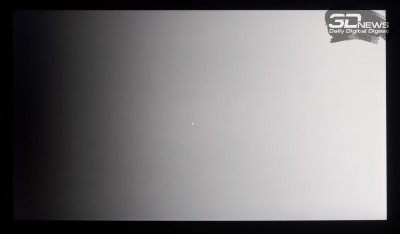 |
The 10-bit (using FRC) matrix used in the AORUS FI27Q-X was able to demonstrate outstanding uniform gradients in all preset modes and after editing the operating parameters through the OSD menu in user modes. Various preset modes “Gamma” do not affect the quality of tonal transitions in any way – nowadays this is a rare phenomenon.
A good factory setting makes it possible, if necessary, to do without a full-fledged calibration with LUT edits and to keep the quality of gradients at an initially high level – with the most correct colors and without obvious banding (sharp transitions in dark areas). During calibration, several sharp transitions with subtle parasitic shades appear on the screen (right photo).

In addition, at any scan frequency, the user can select a 10-bit color representation in the video card settings (but only when using DP 1.4 and a video card not lower than RTX 2060). It is impossible to see a big difference between 8-bit and 10-bit modes (especially considering that FRC is used), and the quality of the gradient reproduction does not change.
⇡ # Response speed and frame skipping
Increasing the vertical scanning frequency leads to the need to reduce the response time, but not every manufacturer is able to find the best option for accelerating the matrix.
In the case of the new FI27Q-X, the native vertical frequency is 240 Hz, available without the need to activate overclocking (Overclock). The response time for GtG is 1 ms, and when inserting a “black frame” in the AIM Stabilizer mode, the time for the frame to appear on the screen is 0,3 ms. The last number should not confuse you – this is not the response time, which should be guided by when choosing.

The monitor has three Overdrive modes. The default Picture Quality value, in our opinion, does not increase the speed, but leaves the picture without artifacts. Moving the OD to the Balance position provokes a slight decrease in trails on moving objects, but we could only notice this from the images we took. With the Speed mode, history repeats itself – it is extremely difficult to notice the difference by eye, and to understand that artifacts have appeared is possible only from a photo. Thus, you can safely choose between the last two Overdrive modes and completely forget about the factory Picture Quality.
When you activate the mode with “black frame insertion” (AIM Stabilizer), any of the adaptive synchronization systems can no longer work, objects become clearer, it becomes possible to read text, but the strongest artifacts are right there.
Compared to its predecessors, the FI27Q-X has an increased level of image smoothness, thanks to the vertical frequency of 240 Hz. The responsiveness of the Sharp panel is at the level of the best representatives of the gaming IPS-segment – this matrix significantly outperforms the competing solution from Innolux used in the AD27QD and FI27Q-P. We can safely call the new FI27Q-X one of the fastest monitors on the market among displays of all classes, with any type of matrix.
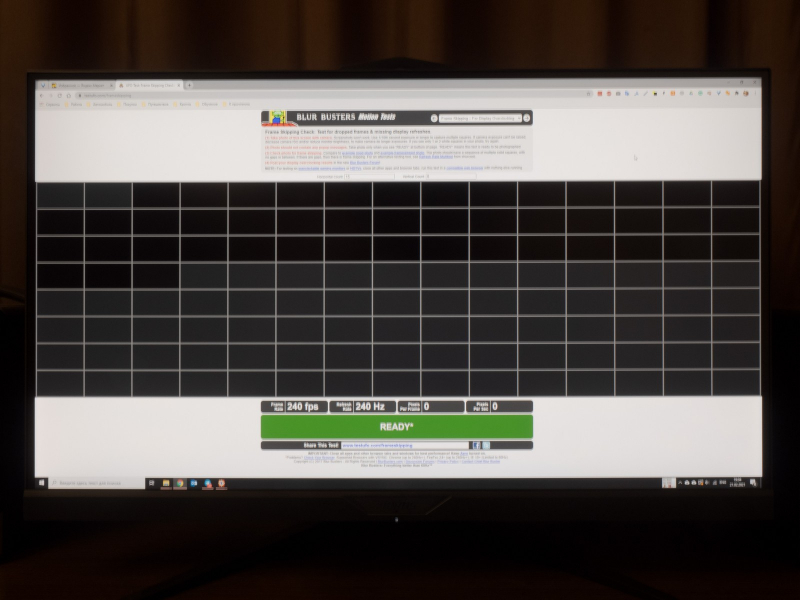
Говоря про стабильность максимальной частоты развёртки, можно отметить, что никаких проблем при тестировании монитора мы не выявили. Специальный тест из пакета TestUFO это полностью подтверждает – 240 Гц стабильны.
⇡ # Viewing angles and Glow—effect
In terms of viewing angles, the monitor in question is not much different from other 27-inch WQHD models with IPS-type panels, demonstrating a high level of picture stability at working viewing angles. Experience has shown that the 27-inch IPS display is still one of the most versatile and practical solutions on the market, despite the rapid development of other panel formats and types.
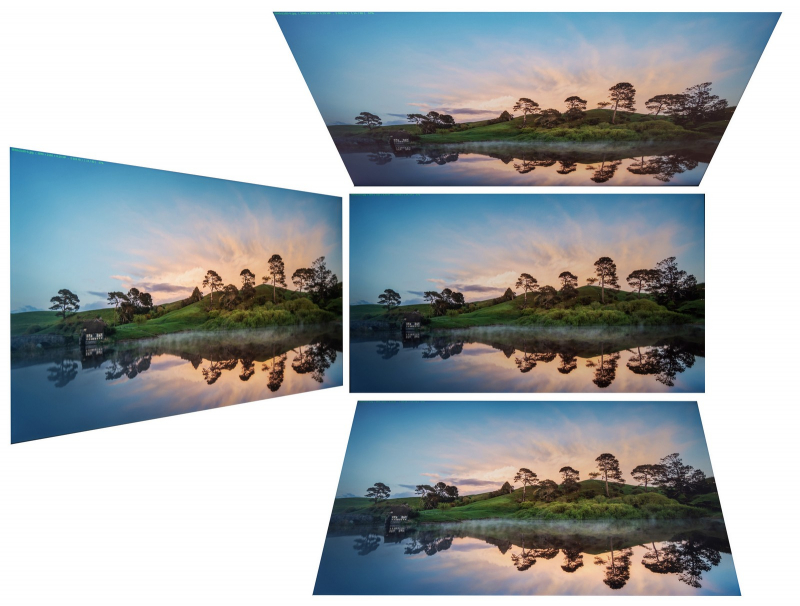
With minor changes in the horizontal plane, the picture on the FI27Q-X screen does not change at all. If the angle is increased to 30-45 degrees, the image becomes slightly less contrasting, the saturation of some colors is slightly reduced, the shadows are slightly lightened – nothing unusual. With changes in the vertical plane, the picture on the screen deteriorates faster and more. The outer areas of the screen, in particular the corners, change their appearance especially strongly.
The monitor under test is not free from the Glow effect, since it is built on the basis of an IPS-type matrix. It is Glow that makes the main contribution to the claims regarding the stability of the picture on the screen and the comfort of working in a dark room, especially when watching movies and working in software with a dark interface. Depending on the position of the user in front of a black-filled screen, the parasitic shade and the degree of its manifestation vary greatly.
На цветных изображениях Glow демонстрирует себя слабо. При взгляде со стороны картинка становится бледной, с легким паразитным оттенком, покрывающем всё изображение.
⇡ # Crystalline effect, Cross-hatching, PWM
The AORUS FI27Q-X monitor uses a matrix with a good semi-matt protective surface.
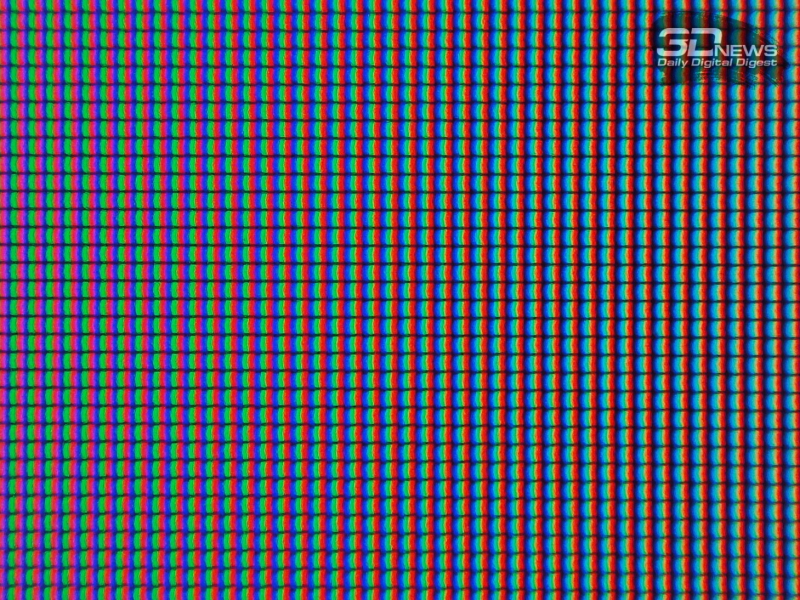
The picture on the screen is pleasing to the eye. The crystalline effect is barely noticeable; many will not see it at all. When you change the viewing angle, its visibility is practically not increased. This display model is completely free from the Cross-Hatching effect.
We did not have any complaints about the display of small elements and the rendering of text of various sizes. The monitor confidently passes all tests and leaves a positive impression of the picture on the screen, especially after reducing the factory sharpness from 6 to 5 units, as with previous brand solutions.
 |
 |
According to the manufacturer, the display has a Flicker-Free-backlight, which was confirmed during our tests. At any brightness level, the ShI modulation is not used, or its frequency is several kilohertz or even tens of kilohertz. For their eyes, users can be calm. It remains not to forget about the need to take breaks from work and not to expose too high brightness in low or medium ambient light.
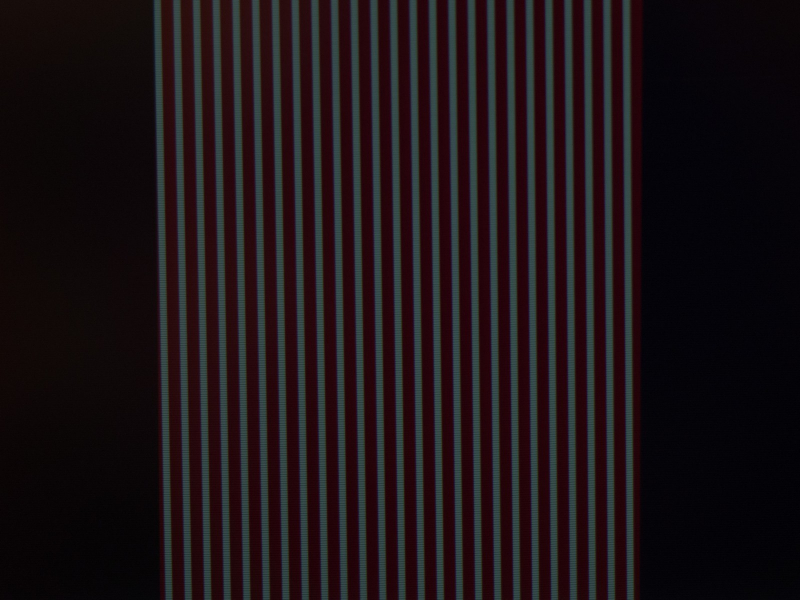
When the AIM Stabilizer mode was activated at a vertical frequency of 240 Hz, we detected a SHI modulation with an appropriate frequency and a high duty cycle – this is how it should be. The load on the eyes in this case, of course, increases, but moving objects on the screen become clearer. For short gaming sessions, this mode may be interesting, but if you work at the monitor for a long time, it should definitely be avoided, especially considering the degree of artifacts.
⇡ # Conclusions
When developing its new monitor, Gigabyte did not change the design and basic capabilities of the device, maintaining continuity with respect to the equally successful predecessors from the AORUS line. At the same time, the main potential of FI27Q-X lies in the used IPS-matrix from Sharp, which is an excellent alternative to Nano-IPS from LG Display.
The development of Japanese engineers surprised us in many ways, and if we consider that this is the first such experience of Sharp that almost left the market, it surpassed all the wildest expectations. Thanks to it, the Gigabyte AORUS FI27Q-X monitor turned out to be one of the first high-speed IPS-displays that are 99-100% compliant with the AdobeRGB color standard, previously found exclusively in expensive professional models.
Gigabyte itself carried out its high-quality adjustment, provided a problem-free sRGB emulation mode for those who are annoyed by high image saturation, and the Overdrive function, even with the maximum degree of amplification, does not provoke the appearance of noticeable artifacts. Throw in the superb smoothness of 240Hz, all the adaptive sync support you need, and you have a great 27-inch WQHD monitor.
In the course of the selection, most likely you will ask yourself the question: is there any point in 240 Hz on a WQHD monitor? There are now two answers to this question: “No” and “No, but it will appear in the future.” Thus, the AORUS FI27Q-X looks like a purchase for the future, with great potential. But if you have enough money and want to get the best now, then why not! Good luck with your choice!
From file server 3DNews.ru can download color profile for this monitor, which we got after manual setup and profiling.
Advantages:
- excellent quality materials and workmanship;
- ergonomic stand and VESA mount;
- a wide range of modern communication interfaces with increased bandwidth (HBR3);
- USB hub with two USB 3.0 ports;
- good delivery set;
- support for PbP / PiP functions;
- большое количество программных «фишек» — многие пройдут мимо, но кому-то они могут пригодится;
- Fusion 2.0 customizable external RGB lighting;
- the possibility of software activation of HDR with support for 10-bit color representation (but the certificate of even the simplest VESA DisplayHDR 400 is not declared);
- hassle-free control system based on a five-position joystick;
- extended color gamut at the level of 99-100% AdobeRGB;
- high-quality factory setting;
- sRGB mode with high-quality emulation of the standard color space and the ability to adjust the brightness of the backlight;
- excellent gradients at any setting (you can do without editing the LUT of the video card with the correct manual settings);
- high stability of shades of gray in most modes;
- a wide range of brightness control with a consistently high contrast ratio (albeit slightly lower than stated);
- high speed and smoothness of the image on the screen at any Overdrive settings – the monitor is one of the fastest solutions on the market;
- support for adaptive sync technologies AMD FreeSync Premium and NVIDIA G-Sync in compatibility mode;
- backlight operation mode with “black frame insertion” (AIM Stabilizer) – analogue of ULMB / ELMB / VRB, incompatible with simultaneous operation with any of the adaptive synchronization systems;
- good uniformity of illumination in a bright field according to the color temperature level (depending on the specimen);
- backlight without flicker (Flicker-Free);
- good viewing angles and weak glow in color images;
- отсутствие Cross-hatching и различимого кристаллического эффекта (КЭ).
Disadvantages:
- strong angular Glow-effect with parasitic shades – in this matter the matrix from Sharp showed itself not from the best side;
- relatively low uniformity of illumination on a black field;
- high price – but against the background of expensive predecessors, the difference is not so big, and, obviously, it is worth overpaying;
May not suit:
- quite deep and wide stand;
- uniformity of illumination in a bright field in terms of brightness below average;
- lack of a built-in speaker system.
If you notice an error, select it with the mouse and press CTRL + ENTER.




